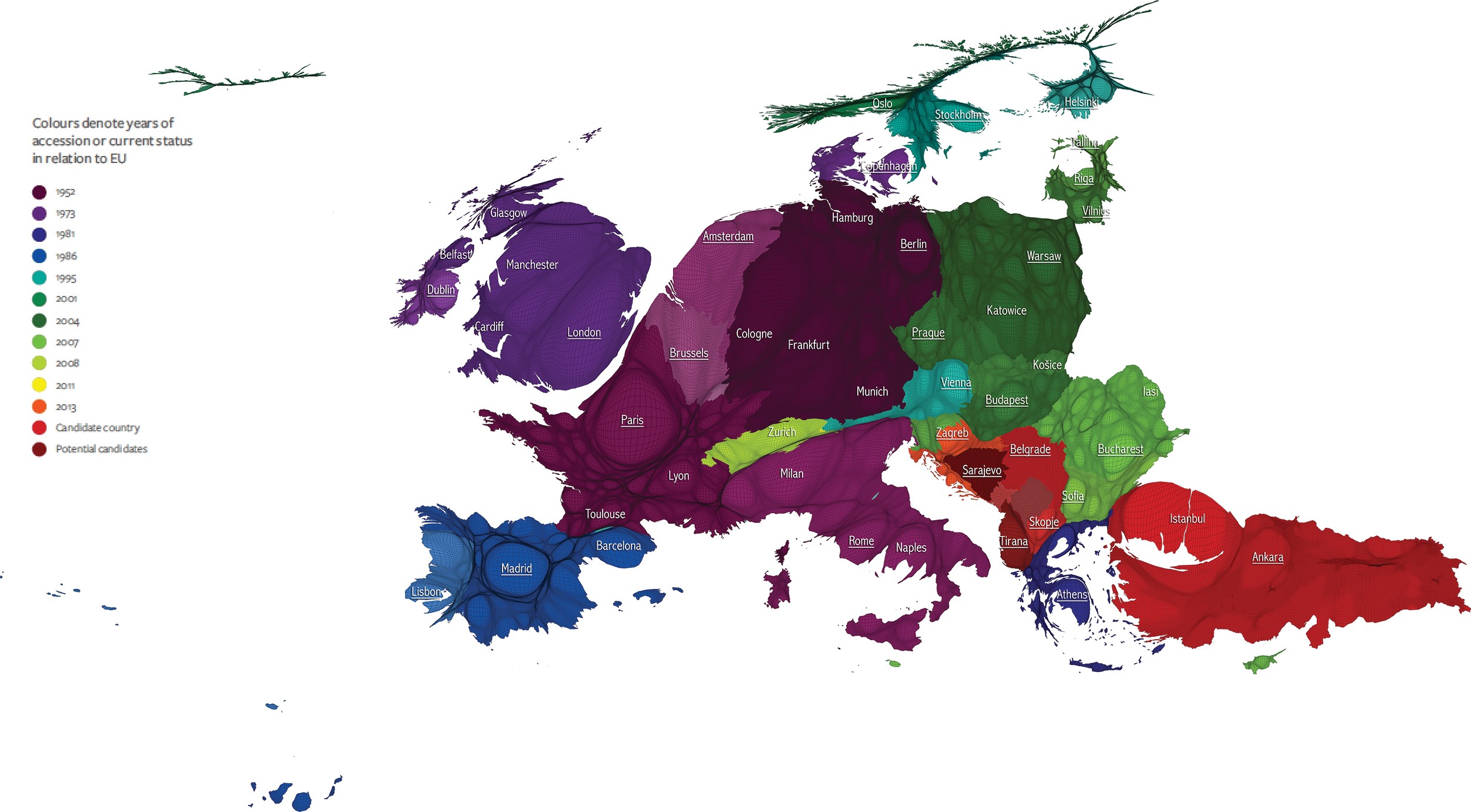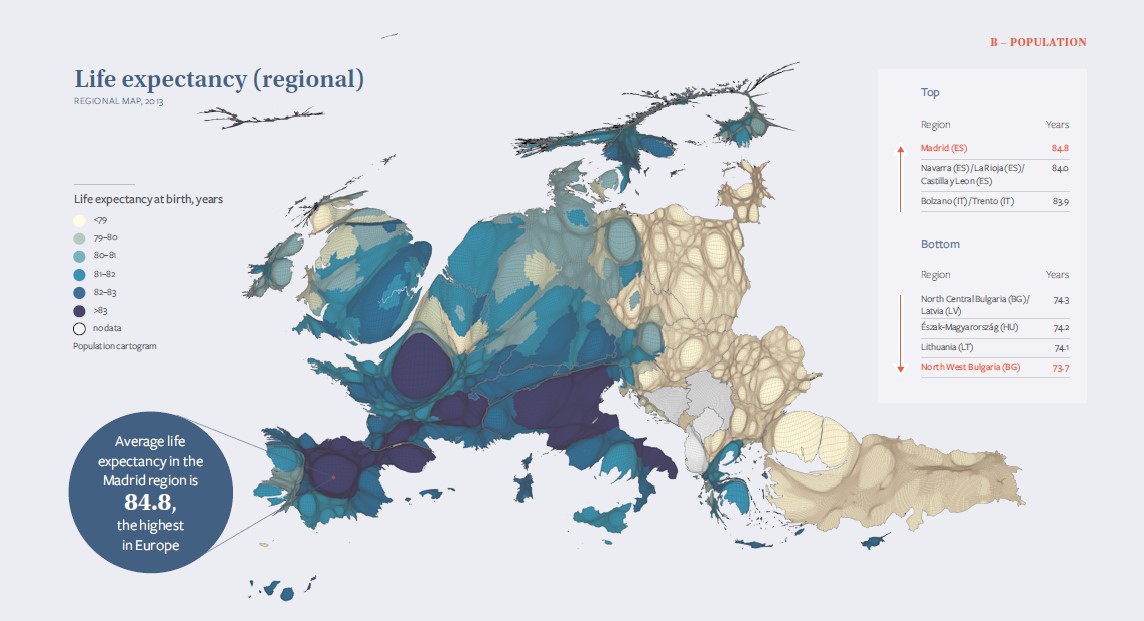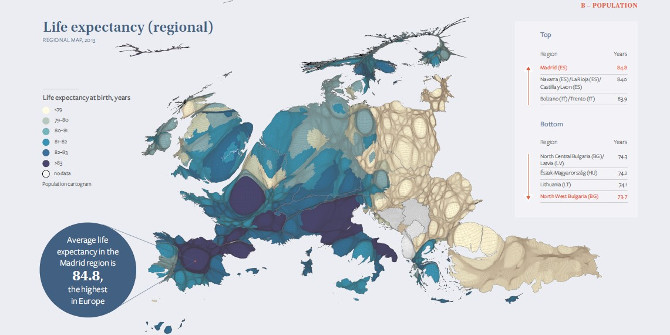Dimitris Ballas, Danny Dorling and Benjamin Hennig present a series of maps drawn from their new ‘Human Atlas of Europe’ that illustrate how life expectancy, wealth, and other key variables differ throughout the continent. Their maps highlight that the real divides across Europe lie within states rather than between them, but also suggest a positive message: that Europe remains a continent united in diversity.
This year marks the 60th anniversary of the Treaty of Rome laying the foundations for an ever closer union of the people of Europe that is underpinned by fundamental ideals including the respect of human rights, freedom of movement, diversity, democracy and peace, solidarity, economic and social cohesion.
Despite being highlighted from the very start, these ideals have not been given the prominence they deserve in most debates about what Europe is about. Instead there has long been a Eurosceptic and increasingly divisive and toxic media discourse led by a number of highly influential newspapers and media outlets, often owned by very wealthy individuals. In the UK, even pro-EU supporters and political parties have often adopted a defensive stance, focusing on national interest and sentiment (‘it is in our interest’: we are ‘stronger in’) rather than offering a positive message and offering a proud reminder of Britain’s leading role in Europe in the past. Elsewhere in Europe, there have also been alarming signs of historical amnesia and nostalgia towards former authoritarian regimes and even an authoritarian turn in some EU member states and candidate member states.
The Brexit referendum result and its aftermath may have worked as a wakeup call for Europe. There has been a surge of support for the EU in big European countries with growing numbers of Europeans joining the #EUFightBack, #UniteForEurope and #PulseOfEurope campaigns across all member states as well as movements such as the New Europeans and My Country? Europe. In addition, very recent post-Brexit elections in Austria, the Netherlands and France were won decisively by pro-European candidates with a positive message for Europe. The new president of France, Emmanuel Macron, shows that patriotism and Europe do not need to be a contradiction. On the eve of his victory he announced: “I’ll defend France, I’ll defend Europe, and will strengthen links between Europe and its people.”
Even in countries where extremism and populism are on the rise, there are signs of inspiring opposition to authoritarianism by the citizens of member states like Hungary where the #IStandWithCEU campaign gains momentum and in candidate member states such as Turkey. In addition, across Europe support for anti-EU parties often falls as quickly as it rises, as shown most recently by UKIP losing every single council seat they previously held in the UK local elections on 4 May 2017.
In a EUROPP blog article that we wrote three years ago, we argued that, as three European geographers whose first languages are Greek, English and German respectively, we felt that the best way for us to contribute to the debates about Europe is to consider and visualise our continent and its economy, culture, history and human and physical geography in terms of a single large land mass.
Three years on we built on our previous efforts and have created The Human Atlas of Europe. This Human Atlas can be used to offer a positive and optimistic message about Europe. It enhances an image of a continent united in diversity and brings to the fore the efforts of so many of its people to work united for peace and prosperity. At the same time, it reminds us that Europe’s many different cultures, traditions and languages are a key asset, benefit and legacy. The atlas includes all states that have demonstrated a strong commitment to a common European future by being closely associated with the EU, either as current members or as official candidate states (or official potential candidates for EU accession) and/or as states which are signed up to any of the following agreements: the European Economic Area, the Schengen Zone, and the European Monetary Union.
These European countries are all shown in the map below using a rainbow colour scale to determine the colour hue for each state according to the year of association with the European Union. Our mapping approach of Europe is based on the idea of redrawing geographical regions on the basis that the area of each should be proportional to the number of people who live in each small neighbourhood, rather than land mass. This kind of visualisation differs from traditional maps and rebalances the emphasis on treating all experiences as equally important rather than greatly highlighting what occurs in the most sparsely populated rural regions.
Figure 1: Map of Europe based on population showing association of states with the European Union (click to enlarge)
Source: The Human Atlas of Europe
The atlas includes different types of maps depending on the nature and availability of data that we had at our disposal in relation to a wide range of themes that are pertinent to European values and identity. The map below is an example of a country-level cartogram relating to the inequality and social cohesion theme where countries are resized in proportion to a variable of interest (in this case total number of US dollar billionaires in each country).
Figure 2: Billionaires in Europe (2015)
Note: Data from Forbes. Source: The Human Atlas of Europe
The map is very relevant to policy debates in Europe and worldwide, especially given the overwhelming evidence about the detrimental impact of inequality upon well-being as well as on democracy. The atlas includes a number of other maps relating to this theme, including poverty, income inequality, unemployment and vulnerable employment.
The next map is another extract from the book, this time showing the regional patterns in life expectancy across Europe. This map is drawn with small areas resized in proportion of the population living within them (see Figure 1 for city labels). The estimated life expectancy by region is then used to shade and classify areas.
Figure 3: Life expectancy in Europe
Note: Data from Eurostat. Source: The Human Atlas of Europe
This map is one of the many examples highlighting important disparities and inequalities, while at the same time showing that the real divides within Europe are more within states rather than between them. One of the aims of our mapping efforts is to inform debates around these issues and to enhance feelings of social cohesion and solidarity among the people of Europe and beyond.
The Human Atlas of Europe includes over 140 maps covering topics ranging from well-being, the refugee crisis, greenhouse gas emissions and Gross Domestic Product to Eurovision voting. The collection of these maps can be used to inform debates about prospects for the future of European identity but also a debates at local, regional, national and European level on the need for establishing socially and environmentally sustainable policies aimed at correcting economic and geographical imbalances and inequalities, building on previous and ongoing efforts and initiatives such as the European Social Fund, The European Regional Development Fund and the Cohesion Fund.
The Human Atlas of Europe comes out at a time when Europe is experiencing the worst global refugee crisis in recent history, following a prolonged severe economic crisis and austerity measures that have disproportionally and brutally hit the most disadvantaged people and places in Europe. However, it is important to remember that these crises and divides are not products of being part of Europe. Europe contains some very steep local social and economic divisions but it is also home to almost all of the economically most equitable regions and countries in the world, the countries with some of the best health care, the best educational outcomes and schools, the best housing quality and services, so many innovative scientists, the most productive of workforces and the most enlightened of societies in terms of respecting and enhancing human rights.
Even when the actions of European governments and institutions divert from the fundamental values and ideals described at the beginning of this article, the solution is not to blame and scapegoat Europe but to hold European politicians to account for not respecting these ideals. One way of doing this in the context of the current refugee crisis is to remind them that it is against European values and European law not to offer refugees safe passage to Europe. It is also important to remember that the European Union has demonstrated an ability to constantly reform and learn from its mistakes.
The Human Atlas of Europe offers a positive message about our continent. A Europe of people united, a Europe of hope rather than a continent in decline. After all, where else in the world is there such diversity, complexity, coherence and communality? Where else in the world have so many people lived in a place where it is illegal for any government to execute any citizen, where people have so many rights, and hopes, responsibilities, and prospects. Where else in the world today do so many millions of people live within a whole they can’t quite see, that they can only imagine, whose borders they are not sure of and whose languages and cultures are so many? Where else but in Europe do so many have so much and yet so often not know what they have? Europe is a continent that is truly united in such diversity.
Please read our comments policy before commenting.
Note: This article gives the views of the authors, and not the position of EUROPP – European Politics and Policy, nor of the London School of Economics.
_________________________________
 Dimitris Ballas – University of the Aegean
Dimitris Ballas – University of the Aegean
Dimitris Ballas is Associate Professor in the Department of Geography at the University of the Aegean.
–
 Danny Dorling – University of Oxford
Danny Dorling – University of Oxford
Danny Dorling is a Professor of Human Geography at the University of Oxford.
–

Benjamin Hennig – University of Iceland
Benjamin Hennig is Associate Professor of Geography at the University of Iceland.









All the data in the world will not convince citizens of nation states that Europe is a single behemoth. Sitting in your ivory towers and scrutinizing the data collected from dubious sources will not replace the feelings of love and patriotism by people for their nations and their nation’s histories. A note for your benefit: The Germans may want to forget and this project of yours would help them do this. .